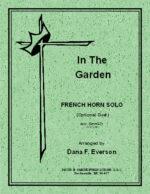-
Sweet Little Jesus Boy (F/Eb solo)
$9.95Often mistaken as a traditional spiritual, “Sweet Little Jesus Boy” was composed in 1934 by Robert MacGimsey who intentionally wrote the song in this style. It harkened back to his youth in Louisiana where he was steeped in the deep tradition of African American gospel music. In this culture, Christmas was a time to draw closer to God through personal prayer and meaningful songs, which was a stark contrast to what he observed in New York when he penned the song.
Written during the depression, “Sweet Little Jesus Boy” quickly became a standard Christmas tune, along with several other songs written at this time. Recorded by many artists over the years, the soulful recording by Mahalia Jackson in 1955 is perhaps the most famous.
-
In The Garden (opt duet)
$5.00A solo instrument with piano accompaniment? Provided with an optional second part for a duet.
-
When I Can Read My Title Clear
$4.50This horn solo begins with a fanfare styled motive of the theme and then calms down to a florid presentation of the tune with a sweeping counterline in the piano. The second section is an imitative interplay between the parts moving into an extended presentation of the melody. The final section is a rather pompous march based on the tune and then moves to a more lyrical movement- much the beginning.
-
Hallelujah Chorus
$5.00A solo instrument with piano accompaniment? Can an arrangement capture the essence of the original with the majesty of full chorus and orchestra? This piece really does- it is amazingly complete!
-
The First Noel
$4.00The introduction is a rousing declamation of a motive from the theme. The theme is presented in tact while the accompaniment supports with a delightful (music-box) movement. The next section is reflective with more counterpoint and then interrupted with a flair of accented variations. The final section concludes with much of the opening flavor and establishes the story with a solid cadence.
-
Christ Arose
$4.50This French horn solo opens with a sense of an early morning awakening and then breaks into a gently modified rendition of the tune. The second section becomes more spirited with a sense of expectation and then settles back down into the mood of the opening, only to become enlivened again. The final section recaps the material from earlier sections and then ends with a statement of victory!
-
Amazing Grace
$4.00After a brief introduction this French horn solo present the tune “as is” while the piano uses two-part imitation lines underneath. The piece progresses with the horn line modifying the tune rhythmically. After a modulation the piano presents the melody in an altered form while the solo has a gentle obligatto. The final section is more punctuated moving to a solemn section of repose.
-
Be Thou My Vision (Opt Duet)
$4.50This French horn solo begins with non-thematic material setting up the mood of the piece. The theme is then introduced in a back-and-forth format between the instrument and accompaniment. It then continues with an altered tune and conventional accompaniment in the background. After modulating upward, the piece becomes more active both rhythmically and theme alterations. The extended final section is flowing where it ends with a strong statement. Optionally, this piece can become a duet with the tenor sax or French horn sets).
-
-
-
Sacred French Horn Folio
$16.95A collection of French horn solos including: Christ Arose, Amazing Grace, Near The Cross, Arise My Soul Arise, Like A River Glorious, Hallelujah Chorus, The First Noel, When I Read My Title Clear
-
-
While Shepherds Watched Flocks By Night
$5.00While having a solemnity about it, this duet exudes a simple joy depicting the picture of a pastoral scene. The duet lines are in constant harmony with each other while punctuating the lines with simple devices. It ends with a simply stated sense of finality and dignity.
-
Arise, My Soul Arise
$5.00A French solo that opens with a simple, dignified and militant style! The middle section is more delicate with the theme embellished to give a sense of bouyancy then migrating over to a more flowing and uplifting feeling. The final section begins lower and then starts its rising to a powerful statement of “having arrived!”













